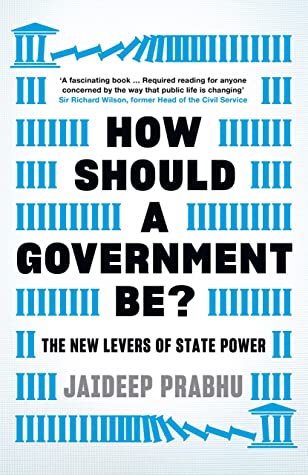How Should A Government Be?: The New Levers of State Power by Jaideep Prabhu - Review by Abhishek Desikan
As citizens of democracies worldwide, we often have varied opinions on the roles and responsibilities of a government and how it should function to serve the needs of the people. Two broad camps exist around the duties of a government. One is the libertarian idea that they’re inefficient and incompetent. Thus, they should play a minimal role and let the market and civil society run the economy. The other is the statist view which considers governments to be all-powerful and the only means to drive community and economy.
What is indeed the role of a government, what are the different models in which they can operate, what dangers may lie with trusting the government too much, and the competence with which they can implement programs to serve the need of the citizens? It is these core questions which this book tries to tackle and address. Finally, it also guides the role citizens should play to ensure a vibrant society with a government that can serve the people’s needs.
The author, Jaideep Prabhu, views the functioning of various governments across the world from a variety of lenses. The breadth of subjects covered is too much to elaborate on in a review. For example, he talks about the historical context of the origins of a socialist approach to planning versus lack of government intervention (Hayek vs. Keynes). He looks at how privatization led to the rise of the US and UK as global superpowers, but how, over time, the lack of financial regulations led to economic crashes and booms and bust cycles. This approach is contrasted with the rise of the Asian tigers and China. There, we are made aware of the possibilities with a market controlled by the state. Similarly, various lessons governments can learn based on successful and failed governance models, from private individuals and organizations to governments themselves, are analyzed in great depth to provide a nuanced and critical view.
One of the recurring themes in the book is the need for governments to adapt to technology to solve problems. The author notes the efficiency of top tech companies like Amazon, Google, and Facebook and how they can achieve incredible penetration and offer services to their users while employing very few people. He envisions governments to achieve a similar efficiency by using similar tools.
Conducting experiments were both highly beneficial in producing conclusive results and analyzing the impact of government actions and thus providing better services to the citizens while helping citizens be more responsible. Things that were particularly noteworthy to me were the working of the experimentation unit (The Nudge Unit) in the UK, which took a bottom-up approach to solve citizen problems by understanding the psychological reasons behind citizens' needs instead of considering them as monolithic templates. Similarly, the employment of mobile-based technology in Bangladesh (a21) and Kenya (M-PESA) has proved highly successful for the same reasons.
The book concludes by highlighting that innovation and market creation require the state and the market to work together and not at odds with each other. The role of the citizens is crucial as well in not just identifying and electing good leaders but keeping tabs on them during their time in power and constantly re-assessing the terms of the social contract. And to protest, if necessary.
An eye-opening book into the world of governments and governance models.

Originally published here.